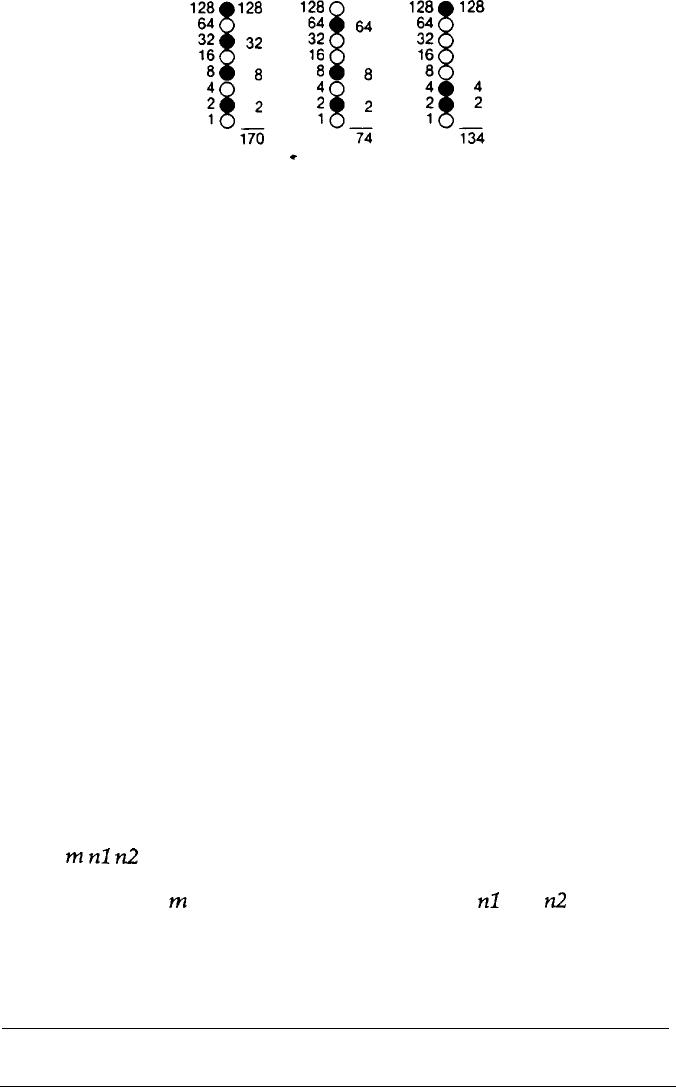Printer User Manual
Table Of Contents
- FRONT MATTER
- TABLE OF CONTENTS
- INTRODUCTION
- CHAP 1-SETTING UP THE PRINTER
- CHAP 2-PAPER HANDLING
- CHAP 3-USING THE PRINTER
- CHAP 4-USING SOFTWARE AND GRAPHICS
- Using the LQ-2550 With Application Programs
- Computer-Printer Communication
- Enhancing Your Printing
- Graphics
- User-Defined Characters
- Designing Your Characters
- Design Grids
- Data Numbers
- Sending Information to Your Printer
- Printing User-Defined Characters
- Copying ROM Characters to RAM
- Letter Quality Characters
- Proportional Mode Characters
- Superscripts and Subscripts
- The Graphics Command
- Column Reservation Numbers
- A simple Graphics Program
- Using Hand-Calculated Data to Print Graphics
- Using Software and Graphics
- Mixing Print Styles
- CHAP 5-MAINTENANCE AND TRANSPORTATION
- CHAP 6-TROUBLESHOOTING
- Troubleshooting
- Problems and Solutions
- The Printer Does Not Print
- The Printer Stops Printing
- The Printout is Spaced Incorrectly
- The Printout is Faint or Uneven
- The Printout is Not what You Expect
- Single Sheets Do Not Feed Properly
- Continuous Paper Does Not Feed Properly
- Cut Sheet Feeder Does Not Load Paper Correctly
- The Short Tear-Off Feature Does Not Work Properly
- Color Printing Is Not What You Expect
- Data Dump Mode
- CHAP 7-USING PRINTER OPTIONS
- CHAP 8-COMMAND SUMMARY
- APPENDIX A-TECHNICAL SPECIFICATIONS
- GLOSSARY
- INDEX

With this numbering system, every combination of the eight pins adds
up to a decimal number between 0 and
255,
and no numbers are
duplicated.
Since there are
24
pins in each column, you must make a calculation for
each of the three sections in each column.
As you
can see, this method of
planning and printing dot graphics requires considerable calculation.
Because triple-density uses 180 columns per inch, printing a single line of
triple-density graphics only one inch long requires
540
numbers.
Fortunately, commercial software can do the calculations for you.
Before you can put these numbers in a graphics program, you need to
know the format of the graphics command.
The graphics command
The graphics mode command is quite different from the other commands
used by the printer. For most of the other printer modes, such as
emphasized and double-wide, one ESCape code turns the mode on and
another turns it off. For graphics, the command is more complicated
because the code that turns on a graphics mode also specifies how many
columns it will use. After the printer receives this code, it interprets the
next numbers as pin patterns and prints them on the paper.
Your printer has one command that allows you to use any of the 11
graphics options. The format of the command is:
ESC *
m
n7
n2
data
In this command,
m
selects the graphics option and
nl
and
YL?
specify the
number of columns to reserve for graphics. The available graphics
options are listed in the following table.
4-16
Using Software and Graphics










